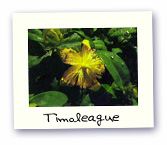 |
Search the site:

Timoleague, County CorkSome of the most varied and profuse gardens are those that have been developed over many generations. At Timoleague no less than five successive generations have left their mark on these charming and informal gardens on the banks of the Argideen River. Colour and interest is further enlivened by a good display of frost-tender plants which thrive in the mild and moist climate of this part of Ireland.Visitors arrive at a car park just inside the front gates, close to the site of old Timoleague House. This was an imposing late Georgian building which for a century was the focal point of the gardens, built by Colonel Robert Travers after he purchased the demesne in 1818 from creditors of the seventh Earl of Barry more. Unfortunately, Timoleague was burnt in 1920 during the Troubles, the Travers family subsequently built a new house in 1926 close to the ruins of the thirteenth-century Barry castle.
A long terraced lawn, originally designed between 1873 and 1874 as the home of a local tennis club, separates the site of the old house from the new. Some of the most interesting plants in the garden are to be found at the south end of this lawn, close to the old house site. Here the visitor will come across a collection of spring-flowering azaleas and magnolias together with some fine mature trees, including an example of
The avenue bank is lined with evergreens and carpeted with cyclamen in autumn. At the top lies a recently restored sunken garden with formal beds and a lily pond. Here visitors will see specimens of the New Zealand cabbage tree (Cordyline australis) and the tall grey-leaved, bright yellow-flowering Moroccan broom (Cytisus battandieri). Above, steps overhung with a lime arch lead up to the Lower Garden where a long double herbaceous border positively thrives: Hydrangea aspera, crimson-flowering Rosa moyesii and the lush, sun-loving Australian 'bottle-brush' (Callistemon linearis) all grow in profusion here. The early nineteenth-century Walled Garden lies past the green houses where a variety of fruit and vegetables are grown. On the way back, the visitor should enter the River Garden that is now being devcloped on the banks of the Argideen, beyond the ruins of the medieval castle.
From the Appletree Press title: Irish Gardens. |
All Material © 1999-2005 Irelandseye.com and contributors

 the very attractive maple Acer cappadocicum 'Rubrum' and the smoke tree (Cotinus coggygria 'Foliis Pur pureis'), whose marvellous plum-purple leaves change to lovely light shades in the autumn. A pleasing find is the shapely Crytomeria japonica 'Elegans', a beautiful variety of cedar with a tall, bushy habit that often succumbs to the windy Irish weather. An unusually large example of a Monterey cypress grows close by as does a foxglove tree, Paulownia tormentosa, and species of the Australian evergreen Pittosporum, all of which do particularly well in this mild seaside climate.
the very attractive maple Acer cappadocicum 'Rubrum' and the smoke tree (Cotinus coggygria 'Foliis Pur pureis'), whose marvellous plum-purple leaves change to lovely light shades in the autumn. A pleasing find is the shapely Crytomeria japonica 'Elegans', a beautiful variety of cedar with a tall, bushy habit that often succumbs to the windy Irish weather. An unusually large example of a Monterey cypress grows close by as does a foxglove tree, Paulownia tormentosa, and species of the Australian evergreen Pittosporum, all of which do particularly well in this mild seaside climate.